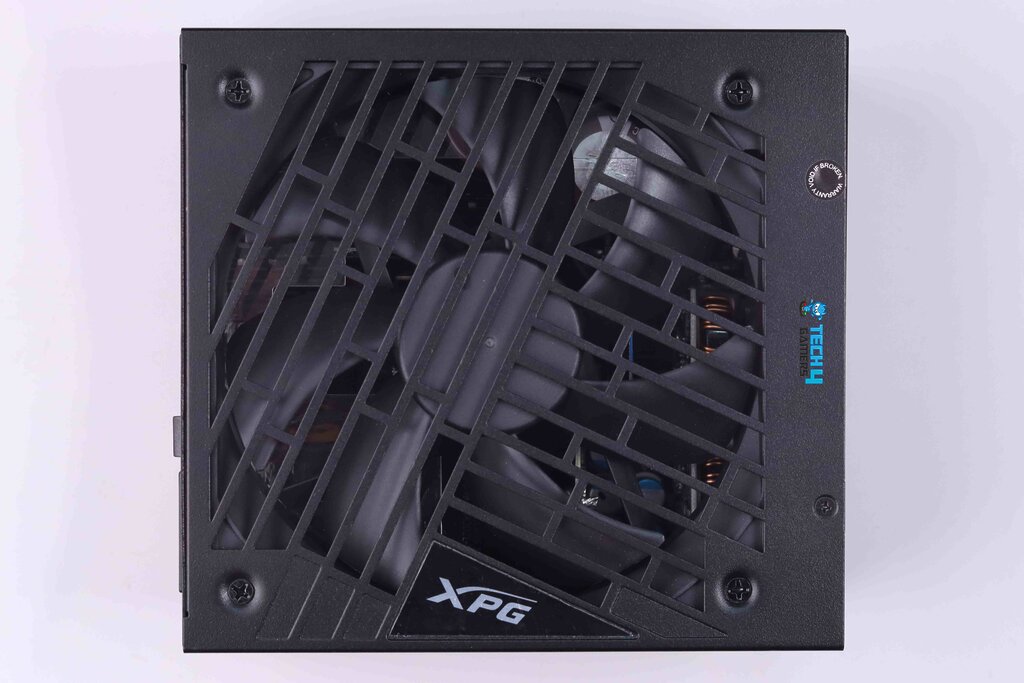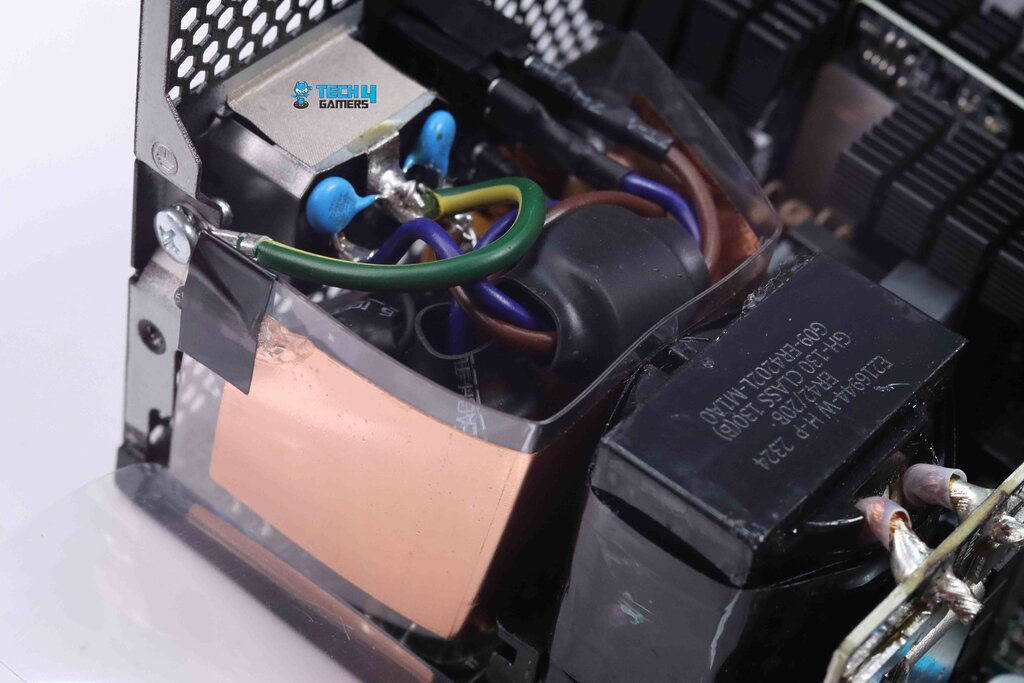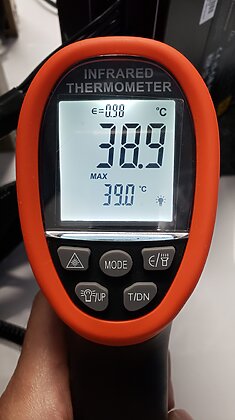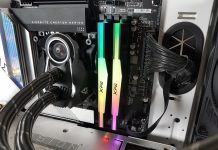Efficiency Meets Gaming!
Review Summary
The XPG Core Reactor II 1200W PSU is a great choice for gamers and PC enthusiasts looking for a reliable PSU. It offers efficient performance and sturdy construction, ensuring your components get the power they need without any worries. With its modular cable design, you can customize your setup for better airflow and aesthetics. Just make sure your PC case has enough space for it, and you’ll be good to go for years of gaming.
Hours Tested: 8

Overall
-
Value - 9.5/10
9.5/10
-
Build Quality - 8.9/10
8.9/10
-
Performance - 9.6/10
9.6/10
-
Future-Proofing - 9/10
9/10
Pros
- Efficient Design
- High-Quality Components
- Competitive Pricing
Cons
- Lack of Hybrid Fan Mode
- Hard sleeved cables
Mid-range PSUs are XPG’s new forte with the Core Reactor II series, which strikes a good mix of price, quality, and performance. Designed with gaming enthusiast’s needs in mind, this XPG Core Reactor II 1200W PSU offers dependable performance, effective thermal control, and a sturdy build. Considering the considerable power consumption associated with advanced motherboards, processors, and graphics cards.
The Core Reactor II 1200W 80 Plus Gold certification distinguishes itself through its efficient design and dependable performance. While providing a reasonable value for budget-conscious individuals in need of more power for their gaming builds.
- Why you can trust Tech4Gamers: Our reviews are based on dedicated hands-on testing by our team of experienced hardware experts. Find out more about how we test.
Key Takeaways
- The XPG Core Reactor II 1200W PSU is a high-performance power supply unit designed with gaming enthusiasts in mind. Featuring an 80 Plus Gold certification, it ensures efficient power delivery to your components while maintaining stable performance.
- What I liked about the XPG Core Reactor II 1200W is that it offers a good balance of price and performance for midrange users.
- What I didn’t like about the XPG Core Reactor II 1200W is that it lacks hybrid fan mode, which is a missed opportunity for silent operation, especially under low loads.
- The XPG Core Reactor II is a perfect fit for gamers as it’s specifically designed with gaming enthusiasts in mind, offering reliable power delivery for high-performance gaming PCs with the latest motherboards and graphics cards.
Here are the specifications:
| Dimensions (L x W x H) | 160 x 150 x 86mm |
| Cybenetics Rating | 1200W: PLATINUM |
| 80 Plus Rating | GOLD |
| ATX Version | ATX 12V v3.0 and EPS v2.92 |
| Protections | OCP | OVP | OPP | OTP | UVP | SCP | NLO | SIP |
| Certification | CE | CB| FCC(IC) | TUV | cTUVus | TUV S-Mark | NOM | BSMI | UKCA | EAC | CCC | RCM |
| PFC | > 0.99 |
| Input Voltage | 100-240V |
| Input Current | 15A |
| Input Frequency | 47Hz-63Hz |
| DC Output Voltage | +5V | +3.3V | +12V | -12V | +5Vsb |
| Total Output | +5V/+3.3V :22A, +12V:100A, -12V:0.3A, +5Vsb:3A |
| Power Excursion | 2820W(*up to 235% of the PSU’s rated power for 100μs) |
| Operating Temperature | 50°C |
| Fan Size | 135mm FDB Fan |
| Fan Bearing | FDB (Fluid Dynamic Bearing) |
| Fan Speed | 2400 RPM |
| MTBF | 100K hours at full load |
| Weight | Product+cables:1.77kg+1.28kg with Package:3.43kg |
| Warranty | 10 Years |
Packaging & Unboxing
The Core Reactor II 1200W PSU is packaged in a durable and aesthetically pleasing box. On the back of the box, you can find all the information you need to know about the PSU, including its dimensions, features, and cable details. The contents of the package are essential and comprehensive. Furthermore, on one side of the box, you can see the efficiency and power supply curve.
You can place the cords you aren’t currently using in the bag they came in as you would need to keep them on bay in case you require them in the future. Two pieces of black foam have been included in the packaging to ensure the protection of the PSU during delivery. Moreover, it is further protected by being enclosed in a plastic bag.
Box Content & Cables
It comes with all the necessary components, such as mounting screws and an AC power line, and even has some stickers to add some flare. The Core Reactor II 1200W PSU comes with a variety of black-colored wires, including connectors. Except regarding the SATA, and Molex cables, the rest of the wires are properly sleeved.
In the package, you’ll get a variety of cables from XPG, which includes a Power Cable, 1x Motherboard 20+4 Pin, 2x ATX 12V 4+4 Pin CPU, 1x PCI-E 12VHPWR 12+4Pin, 1x PCI-E 12VHPWR 12+4Pin to x2 6+2 Pin, 3x PCI-E 6+2 to 6+2 Pin, 3 SATA Cables, and 3 Molex Cables. They provide dependable performance that is compatible with current and future components.
The only issue we find with XPG PSUs along with a few other manufacturers is the fact that they are still using hard-sleeved cables that can be quite a nightmare in cable routing/managing especially in small PC cases.
Design
With its modern matte black appearance, the PSU is both aesthetically pleasing and sufficient. It prevents an overly showy design by incorporating geometric fan cutouts and embossed patterns. Its 160 mm length is just a little longer than standard ATX, but it’s still adequate enough to work with top-tier PC cases that are ATX compliant.
A comprehensive label is placed on the upper surface of the device, showing its electrical specifications as well as its certifications. Minimalist in appearance, the front of the PSU just has an on/off switch and an AC outlet; nevertheless, the back is meticulously engineered to facilitate precise wire connections. Furthermore. it is meticulously built to prevent overheating. With the honeycomb mesh design with airflow being maximized.
Cable Connections

XPG Core Reactor provides full-modular cable connections and is tailor-made for powerful systems and high-end graphics cards. The back panel for connecting the cables at the back is compelling. XPG has written the labels in conventional orientation, right side up. The arrangement is quite logical, with similar connectors grouped together.
The Core Reactor II 1200w PSU’s input side has two 24-pin motherboard cables that include 18-pin and 10-pin connectors. What follows is the 12VHPWR connection, which has a 12+4 pin layout. The five VGA and CPU 8-pin connectors can be found in the bottom right corner and far right.
On the other hand, the MOLEX and SATA connectors have three inputs and connect via 6-pin. With a suitable array of inputs that corresponds to the number of connections on each modular cable, XPG has done an excellent job in this aspect. It should satisfy enthusiasts and casual users equally.
Fan

A Hong Hua HA13525H12SF-Z fan, measuring 135 mm in diameter, is utilized for cooling purposes on the XPG Core Reactor II 1200W PSU. This fan fits snugly within the frame, which is marginally larger than the standard for ATX boards. The exceptional quality of this fan is showcased by its Fluid Dynamic Bearing.
It is commonly used in high-performance PSUs due to its reputation for long life and low noise output. The 135 mm fan is used to control the temperature of the power supply by taking air from the base and directing it over its internal components. At the rear of the power supply, there is a big secondary honeycomb mesh space that allows exhaust heat to escape.
Even when exposed to high power output and a wide range of testing circumstances, the fan consistently maintains reasonable internal temperatures, demonstrating outstanding performance. Without any problems, the temperature remained much below its rated working temperature, and the fan remained rather silent. The fan’s ability to adapt its speed in response to load allows for effective cooling with minimum noise.
Teardown & Component Analysis

XPG has a strong belief in CWT, which has been the OEM of their PSUs ever since XPG is in the PSU business. Many PSU manufacturers opt for CWT platforms and request slight design changes or component selections depending on the price segment. Unlike other brands, we have seen XPG picking up one of the best quality components for even their low-budget price segment PSUs.
So we surely expect absolutely no compromises on the build quality of two of their PSUs, XPG 1200W Core Reactor II & XPG Cyber Core 1000W II. As we have mentioned above, XPG Core Reactor II is made by CWT, and it’s their upgraded CSZ platform to accommodate intel’s latest ATX3.0 specifications and new 12VHPWR connector. The same platform is extensively being used in several other brands’ PSUs these days, glorifying the capabilities of CWT’s new design.
We see Active PFC and Half-Bridge + LLC topology on the primary side and Synchronous Rectification and DC-DC converters on the secondary side, making this an easy contender for achieving a Gold rating on paper.
XPG has opted for 100% Japanese Electrolytic capacitors from several top-of-the-line manufacturers such as Nippon-Chemicon & Rubycon.
The PSU’s PCB is densely populated, but thanks to no cable routings inside, it gives enough room for air to properly circulate and cool down the components.
The 12V rail transformer and its MOSFETs always do heavy lifting in order to make the conversion efficient and cool, and all 12V MOSFETS are soldered on the vertical daughterboard. This board also helps soak in the heat generated from the MOSFETS.
How Do We Test?
At Tech4Gamers, we take a unique approach to PSU testing. Instead of just relying on certifications or lab tests, we subject PSUs to real-life challenges. We’ve developed our own special PSU tester to measure how well a PSU handles stress accurately. Our main focus is on evaluating how well PSUs perform in gaming computers. We assess the stability of voltage, efficiency, temperature, and noise levels. This allows us to provide all the necessary information for people to choose the right PSU for their gaming setup, whether they’re building a high-end rig or working with a budget build.
PSU Load Testing
12V & Minor Voltage Rails Regulation

| Load in % | 12V | 5V | 3.3V |
| 20% | 12.14V | 5.05V | 3.31V |
| 50% | 12.06V | 5.05V | 3.31V |
| 70% | 12.02V | 5.04V | 3.30V |
| 90% | 12.00V | 5.04V | 3.30V |
| 100% | 11.98V | 5.04V | 3.29V |
Voltage regulation is outstanding. This could further be improved by utilizing Digital Controller for 12V rail, but then it would automatically result in added cost.
PSU Efficiency

| Load in % | Power Factor | Efficiency |
| 20% | 0.957 | 91% |
| 50% | 0.965 | 93% |
| 70% | 0.984 | 93% |
| 90% | 0.987 | 92% |
| 100% | 0.988 | 92% |
XPG may have got this platform slightly tuned up for its efficiency because we are seeing numbers easily exceeding Gold efficiency and almost reaching Platinum performance. Good job there!
Voltage Ripple Performance

| Load in % | Voltage Ripple |
| 20% | 12.8mV |
| 50% | 7.2mV |
| 70% | 9.6mV |
| 90% | 12.4mV |
| 100% | 14mV |
One of the things CWT’s new ATX3.0 platforms have improved significantly is their voltage ripple performance. The same is the case with XPG Core Reactor II. This new design has made it easier for the overclockers not to spend a fortune on the cleanest output PSUs.
Temperatures
Because of tuned-up efficiency, temperature performance is really good. Unfortunately, XPG has missed a massive opportunity by not utilizing the Hybrid Fan mode design in their Core Reactor II lineup, which would have resulted in silent operation. Considering the fact that this platform from CWT does offer Hybrid Fan mode, it’s quite a bummer that XPG didn’t opt for it.
Though we do recommend that you turn this feature off anyway because it can prolong the life of the PSU even beyond its warranty period, this should be left to users to decide at their convenience.
12VHPWR Cable Performance On Max Load
12VHPWR cable sustained the load of 600W without breaking a sweat at the voltage level of 11.93VV.
Should You Buy It?
Buy It If
✅You prioritize reliable and efficient power delivery for your gaming or high-performance gaming needs.
✅You value flexibility and customization in cable management with a full-modular cable design.
Don’t Buy It If
❌You want silent operation during light workloads as it excludes Hybrid Fan mode.
❌You want to use it inside a smaller PC case. Its long and hard-sleeved cables can be quite challenging to route in tight spaces.
Final Verdict
The Core Reactor II 1200W PSU offers an excellent performance-to-price ratio. It is a great option for those seeking a midrange PSU that balances price, efficiency, and dependability. With its innovative design and sturdy build, the Core Reactor II is built to last. It uses high-quality Japanese capacitors that are rated at 105°C, which increases its endurance.
Its strongest points are the PSU’s high energy conversion efficiency and superior power quality. Moreover, its performance is sufficient for the majority of users who need powerful components for gaming or content production without experiencing persistent overheating caused by demanding professional workloads and overclocking.
Coming Next: DeepCool PX1000P 80 PLUS Platinum Review
Thank you! Please share your positive feedback. 🔋
How could we improve this post? Please Help us. 😔
Feedback By:
Greg Romero
[Hardware Reviewer]
After many years of exploiting various pieces of hardware, Abdul Hannan now serves as an editor at Tech4Gamers. He’s been in the PC hardware reviewing industry for almost a decade, and his staff of passionate geeks and reviewers is second to none.
Abdul Hannan is constantly seeking new methods, you will always see him running into New Computer Courses to improve the performance of his computer components since he is an ardent overclocker. He is well-known for providing the most extensive and unbiased analysis of the newest and greatest hardware for PC gaming, including everything from GPUs to PSUs.


 Threads
Threads




















